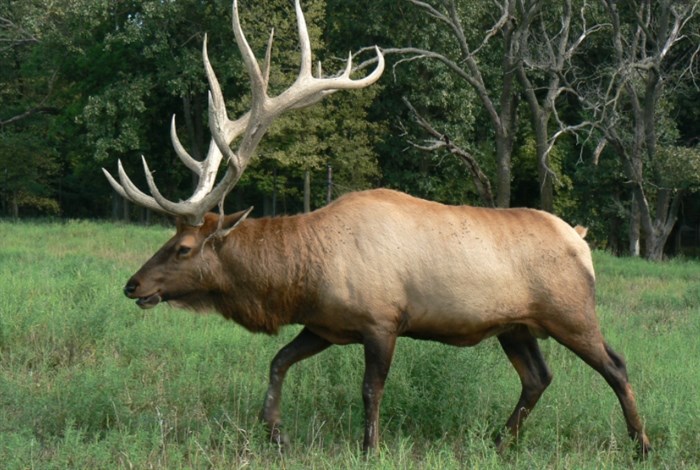
A bull elk stag.
Image Credit: Wikimedia Commons
June 25, 2021 - 6:30 AM
Unbeknownst to most Okanagan residents, there are hundreds of Rocky Mountain Elk within 20 to 30 minutes of downtown Kelowna.
“For such big animals they do an amazing job of existing under our noses without us knowing about them,” Craig McLean, a provincial government wildlife biologist for the Thompson-Okanagan region told iNFOnews.ca.
They’re also known as one of the noisiest wild animals in the province.
“They talk a lot,” McLean said. “They’re very vocal. They mew and squeal at each other quite a bit. They’re herding animals so they move in large groups so quite often you’ll hear them moving through the forest. I’ve listened to cow elk coming through the forest and you’d think there’s a troop of school kids coming towards you, they’re so loud.”
Residents of the Joe Rich area, just east of Kelowna, raised the impact on the elk as one of their concerns over a recently proposed gravel pit across Highway 33 from Heartland Ranch.
READ MORE: Proposed gravel pit near Kelowna gets unanimous thumbs down from regional district directors
“We’re seeing elk a lot more now in that area, particularly at Heartland, after hunting season — it seems like the next day — we look in that field and there are hundreds of elk grazing like cattle,” Laurie Takoff, secretary of the Joe Rich Ratepayers and Tenants Society told iNFOnews.ca, noting they migrate through the proposed gravel pit down to the Heartland grassland on their way to Mission Creek.
“They come through in early spring then again in the fall,” Joanne Little, campground manager for Heartland said. “They usually come in huge packs and stay for the night, then they leave.”
By huge packs she means up to 40 elk that graze on the ranch’s grasslands and have often attracted motorists along the highway who stop to take photos.
As for being loud, she’s heard the odd bull bugling but generally doesn’t know they’re around unless she spots them in the fields.
“They’re very peaceful and very, very beautiful,” Little said.
There are two basic herds in the Central Okanagan area. One is in the Okanagan Mountain Park/Myra Canyon area while the other, called the Black Mountain herd, ranges from the Joe Rich area all the way up to Oyama, Kalamalka Lake and some go as far as Falkland.
They get more numerous east of the Okanagan into the Christian Valley, Rock Creek and through to Christina Lake.
There are also small groups of elk in the Thompson and Cariboo areas, although they are most populous in places like the Kootenays and northern B.C.
“Elk are grazers,” McLean said. “They like clearcuts. They like open grasslands that have been opened up through forest fires or habitat restoration works. They do quite like our farm fields as well. They seem to do pretty well with how we’ve modified the land.”
He estimates the population in the region numbers in the hundreds and is stable or growing. Populations throughout the province fluctuate but, in balance, are stable.
At one point they became so numerous in the Peace River country that hunting was increased to protect farmers’ fields, Kiff Covert, owner of Covert Outfitting, said.
“They’re driven down (into the Okanagan) because of the snowpack,” he said. “As the snow piles up, they move lower. Once they’re down on those lower elevation properties it’s because there’s so much snow up in the mountains. They don’t deal with deep, deep snow very well but it’s easy there because they only have to drop down a little until they’re out of it.”
They move higher and further east in the warmer months.
“While Elk are more commonly found in mountainous areas, they are adaptable and can tolerate sporadic tree cover, and our dry climate,” Meg Bjordal, WildSafeBC’s Central Okanagan coordinator said in an email.
While elk tend to stick together in smaller herds and within a limited range, they can travel extensively.
One tagged cow followed the grasslands from Quesnel, down through the Thompson-Nicola region before hooking up with a herd near Princeton, McLean said.
Another swam Harrison Lake, crossed the Fraser River and the Coquihalla highway and ended up in Princeton as well.
“The elk must have an email distribution list about Princeton being the place to be,” McLean joked. “It’s kind of a melting pot they seem to end up in.”
Elk are large, with bulls ranging up to 140 cm (55 inches) tall at the shoulders and weighing up to 410 kg (900 pounds).
Moose, by comparison, can stand up to two metres (79 inches) tall and weigh up to 600 kg (1,300 pounds).
While herds of elk have been spotted in Joe Rich, in fields near Kelowna Airport and even spotted crossing the highway north of Vernon, many witnesses to their movements don't actually have photos. If you have pictures of elk in the Okanagan or Thompson regions, please send them along to news@infonews.ca.
To contact a reporter for this story, email Rob Munro or call 250-808-0143 or email the editor. You can also submit photos, videos or news tips to the newsroom and be entered to win a monthly prize draw.
We welcome your comments and opinions on our stories but play nice. We won't censor or delete comments unless they contain off-topic statements or links, unnecessary vulgarity, false facts, spam or obviously fake profiles. If you have any concerns about what you see in comments, email the editor in the link above.
News from © iNFOnews, 2021